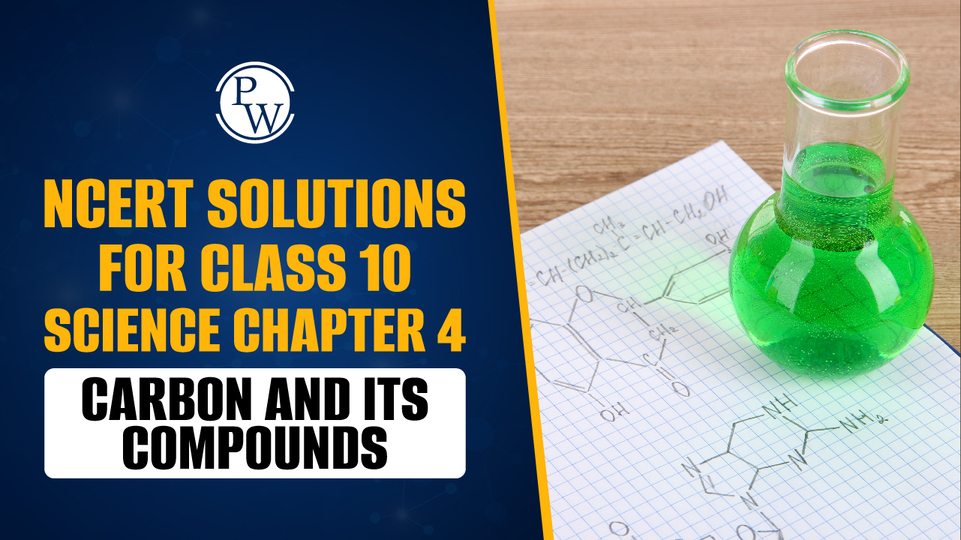NCERT Solutions for Class 10 Science Chapter 4 Carbon and Its Compounds

NCERT Solutions for Class 10 Science Chapter 4 Carbon and Its Compounds are important for students as it is one of the key chapters of their Science syllabus. Carbon and Its Compounds Class 10 Chapter tells us how carbon forms so many different compounds and why it is such an important element in our lives. NCERT Carbon and its Compounds Class 10 Solutions provided here include all the textbook questions with answers in an easy-to-understand way to boost your overall understanding of this chapter.
Additionally, these answers also help in doing homework, revision, and give an idea about how to write answers correctly during exams. So, keep reading to find the detailed NCERT Solutions for Class 10 Science Chapter 4.
Check Out: CBSE Class 10th Books
NCERT Solutions for Class 10 Science Chapter 4 Carbon and Its Compounds
To help students understand the chapter better, we have provided all the textbook Carbon and its Compounds Class 10 questions with answers in a simple and clear way. Check out the solutions below that will help you with understanding the chapter better, doing homework, and preparing for exams.
Page Number 61:
Ques. 1. What would be the electron dot structure of carbon dioxide, which has the formula CO 2 ?
Solution:
Ques. 2. What would be the electron dot structure of a molecule of Sulphur which is made up of eight atoms of Sulphur? (Hint – The eight atoms of Sulphur are joined together in the form of a ring).
Solution:
Read More: NCERT Solutions for Class 10 Science Chapter 1
Page Number: 68 – 69:
Ques. 1. How many structural isomers can you draw for pentane?
Solution:
The structural isomers of pentane are as follows:
i) n-pentane
ii) 2-methylbutane
iii) 2, 2-dimethylpropane
Ques. 2. What are the two properties of carbon which lead to the huge number of carbon compounds we see around us?
Solution:
The following are two characteristics of carbon that contribute to the enormous variety of carbon compounds that surround us:
-
Six valence electrons on carbon is actually a large number of valency electrons.
-
With carbon atoms and many other atoms, including oxygen, chlorine, nitrogen, sulphur, hydrogen, etc., covalent bonding is simple.
Ques. 3. What will be the formula and electron dot structure of cyclopentane?
Solution:
The formula and electron dot structure of cyclopentane are as given below:
Ques. 4. Draw the structures for the following compounds.
(i) Ethanoic acid
(ii) Bromopentane*
(iii) Butanone
(iv) Hexanal
Solution:
i)
ii)
iii)
iv)
Ques. 5. How would you name the following compounds?
-
CH 3 —CH 2 —Br
-
-
Solution:
-
Bromoethane
-
Methanal or Formaldehyde
-
1 – Hexyne
Read More: NCERT Solutions for Class 10 Science Chapter 2
Page Number 71:
Ques. 1. How is the conversion of ethanol to ethanoic acid an oxidation reaction?
Solution:
This is an oxidation reaction that turns ethanol into ethanoic acid by taking off the hydrogen atom and adding oxygen. To create ethanal, ethanol must first lose one of its H2 molecules. The process is an oxidation reaction because the loss of hydrogen is an oxidation. In a similar manner, ethanal is converted to ethanoic acid by adding an oxygen atom. The reaction is an oxidation reaction because the process of gaining oxygen is known as oxidation.
Ques. 2. A mixture of oxygen and ethyne is burnt for welding. Can you tell why a mixture of ethyne and air is not used?
Solution:
Because heat production is crucial for welding metals, a mixture of oxygen and ethyne is burned during the welding process rather than ethyne and air. The temperature that is produced when oxygen and ethyne burn entirely is higher than that of air and ethyne. A blue flame that is extremely hot when oxygen and ethyne are combined produces a sooty flame, which indicates that certain particles are still unburned and results in less heat.
Read More: NCERT Solutions Class 10 Science Chapter 3
Page Number 74:
Ques. 1. How would you distinguish experimentally between an alcohol and a carboxylic acid?
Solution: In reaction with sodium carbonate, carboxylic acids produce carbon dioxide gas which turns lime water milky, whereas alcohols do not give this reaction. This experiment can be used to distinguish alcohol and carboxylic acid.
The reaction of the carboxylic acid with sodium carbonate: 2CH 3 COOH + Na 2 CO 3 → 2CH 3 COONa + H 2 O + CO 2
Ques. 2. What are oxidising agents?
Solution: Compounds that either add oxygen to a molecule or take hydrogen from it are known as oxidising agents. For instance, nitric acid, potassium nitrate, and halogens.
Page Number 76:
Ques. 1. Would you be able to check if water is hard by using a detergent?
Solution: It is not possible to determine the hardness of water by employing detergents, which are ammonium salts or sulphonates of long-chain carboxylic acids. They do not react with calcium and magnesium to determine the type of water, in contrast to soaps.
Ques. 2. People use a variety of methods to wash clothes. Usually, after adding the soap, they ‘beat’ the clothes on a stone, or beat it with a paddle, scrub with a brush or the mixture is agitated in a washing machine. Why is agitation necessary to get clean clothes?
Solution: In order to get clean garments, agitation is required since it helps the soap micelles capture oil, grease, and other contaminants that need to be eliminated. Particles from their surfaces are washed into the water when they are beaten or otherwise disturbed, cleaning the clothing in the process.
Check Out: CBSE Class 10th Question Banks
Exercise Questions, Page Number 77-78
Ques. 1. Ethane, with the molecular formula C 2 H 6, has
(a) 6 covalent bonds
(b) 7 covalent bonds
(c) 8 covalent bonds
(d) 9 covalent bonds
Solution:
Answer: (b) 7 covalent bonds
Ethane, with the molecular formula C 2 H 6, has 7 covalent bonds.
Ques. 2. Butanone is a four-carbon compound with the functional group (a) carboxylic acid (b) aldehyde (c) ketone (d) alcohol
Solution:
(c) ketone
Ques. 3. While cooking, if the bottom of the vessel is getting blackened on the outside, it means that
(a) The food is not cooked completely
(b) The fuel is not burning completely
(c) The fuel is wet
(d) The fuel is burning completely
Solution:
Answer: (b) The fuel is not burning completely
While cooking, if the bottom of the vessel is getting blackened on the outside indicates that the fuel is not burning completely.
Ques. 4. Explain the nature of the covalent bond using the bond formation in CH 3 Cl.
Solution:
Since these reactions cost more energy and cause the system to become unstable, carbon is unable to gain or lose four electrons. As a result, CH3Cl shares its four electrons with carbon atoms or atoms of other elements to complete its octet configuration. Therefore, the bonding present in CH3Cl is covalent in nature. In this case, one electron is needed by each hydrogen atom to complete its duplet, whereas four electrons are needed by carbon to complete its octet. In addition, chlorine needs one electron to finish the octet. Since they are all sharing electrons, carbon makes three bonds with hydrogen and one with chlorine.
Ques. 5. Draw the electron dot structures for
(a) ethanoic acid
(b) H 2 S
(c) propanone
(d) F 2
Solution:
a)
b)
c)
d)
Ques. 6. What is a homologous series? Explain with an example.
Solution:
A collection of substances with the same functional group is called a homologous series. The general formula and chemical characteristics of this are likewise comparable. We can state that there would be a rise in molecule mass and size since there is a change in the physical characteristics. For example, methane, ethane, propane, butane, etc., are all part of the alkane homologous series. The general formula of this series is C n H 2n+2 . Methane CH 4 Ethane CH 3 CH 3 Propane CH 3 CH 2 CH 3 Butane CH 3 CH 2 CH 2 CH 3 . It can be noticed that there is a difference of −CH2 unit between each successive compound.
Ques. 7. How can ethanol and ethanoic acid be differentiated on the basis of their physical and chemical properties?
Solution:
|
Ethanol |
Ethanoic acid |
|
It does not react with sodium hydrogen carbonate |
Bubbles and fizzes with sodium hydrogen carbonate |
|
A good smell |
Smells like vinegar |
|
No action in litmus paper |
Blue litmus paper to red |
|
Burning taste |
Sour taste |
Check Out: CBSE Class 10th Previous Year Papers
Ques. 8. Why does micelle formation take place when soap is added to water? Will a micelle be formed in other solvents, such as ethanol also?
Solution: Micelle formation takes place because of the dirt particles in water and clean water. There are two mediums that are involved: one is pure water, and the other is dirt, also called impurities. The soap also has two mediums:
(i) organic tail (ii) ionic head Thus, the ionic head and oil or grease dissolve and mix with the water, while the organic tail combines and dissolves with the dirt. As a result, the soap molecules in the water pull the dirt away from the object that has to be cleaned. As a result, the micelles' (positively charged heads) reciprocal repulsion causes the soap to form closed structures that clean. Other solvents, including ethanol, are unable to generate these micelles because the sodium salt of fatty acids does not dissolve in it.
Ques. 9. Why are carbon and its compounds used as fuels for most applications?
Solution: Carbon and its compounds are used as fuels for most applications because they have high calorific values and give out a lot of energy. Most carbon compounds give a lot of heat and light when burned in the air.
Ques. 10. Explain the formation of scum when hard water is treated with soap.
Solution: Scum is produced from the reaction of hard water with soap. Calcium and magnesium present in the hard water form an insoluble precipitate called scum.
Ques. 11. What change will you observe if you test soap with litmus paper (red and blue)?
Solution: An alkaline solution is produced when soap dissolves in water and forms an alkaline NaOH or KOH solution. The blue litmus stays blue in the soap solution, whereas the red litmus turns blue in the solution.
Ques. 12. What is hydrogenation? What is its industrial application?
Solution: A process or chemical reaction involving hydrogen and other substances is known as hydrogenation. Usually, catalysts are present when it is done. For instance, platinum, palladium, or nickel. The primary purpose of hydrogenation is to saturate organic molecules.
Ques. 13. Which of the following hydrocarbons undergo addition reactions: C 2 H 6, C 3 H 8, C 3 H 6, C 2 H 2, and CH 4?
Solution: Unsaturated hydrocarbons undergo addition reactions. C 3 H 6 and C 2 H 2 are unsaturated hydrocarbons that undergo addition reactions.
Ques. 14. Give a test that can be used to differentiate between saturated and unsaturated hydrocarbons.
Solution: Alkenes and alkynes are examples of unsaturated chemicals. The bromine water test is used to distinguish between these and other saturated compounds. Bromine is employed in the form of bromine water for this purpose.
Bromine water is a solution of bromine in water. Because bromine is present in it, the water is reddish-brown in hue. When an unsaturated compound is mixed with bromine water, the unsaturated molecule absorbs the bromine, and the reddish-brown bromine water is released. Hence, an unsaturated hydrocarbon (one that has a double or triple bond) will decolorise bromine water; saturated hydrocarbons, or alkanes, on the other hand, do not decolorise bromine water.
To distinguish between saturated and unsaturated chemicals (such as alkenes and alkynes), the bromine water test is used. An unsaturated hydrocarbon releases its reddish-brown bromine solution when bromine water is introduced. Therefore, the chemical will be an unsaturated hydrocarbon if there is discoloration.
Ques. 15. Explain the mechanism of the cleaning action of soaps.
Solution: Water is contaminated with a great deal of pollutants and dirt, which don't dissolve in the water. Soap molecules consist of a mixture of salts, like potassium and sodium. The molecules are linked carboxylic acids in a lengthy chain. Thus, the soap begins to clean and trap the dirt when the ionic end dissolves in water and the carbon chain dissolves in oil.
In order to collect the oil droplets, the soap molecules create structures known as micelles, which have ionic faces on one end. When the clothing is washed, this will create an emulsion in the water and aid in the dissolution of any dirt or contaminants.
At different ends, the soap molecules exhibit distinct characteristics. Both ends have two distinct properties: the hydrophilic end is soluble in water and attracts water, whereas the hydrophobic end dissolves in hydrocarbons and repels water. Because the hydrophobic tail is insoluble in water, it aligns itself along the water's surface.
Check out: CBSE Class 10th Revision Books
Summary of Carbon and Its Compounds Class 10 Science Chapter
Now that you have the Class 10 Science Chapter 4 question answer, let’s quickly go through the summary of this chapter. It’s important to understand the main ideas clearly so that you can grasp the Class 10 Carbon and Its Compounds solutions better.
Unique Properties of Carbon
Carbon is a very special element. It can form strong bonds with other carbon atoms. Because of this, it can make long chains, rings, and branches.
-
This property of carbon is called catenation. No other element shows this property so well.
-
Carbon also has four valence electrons. It can form four covalent bonds with other atoms at the same time.
-
This is called tetravalency. Because of catenation and tetravalency, carbon forms many different compounds. These are called carbon compounds.
Types of Bonds in Carbon Compounds
Carbon compounds usually have covalent bonds. In covalent bonding, atoms share electrons with each other.
-
Carbon can form single, double, or triple covalent bonds. These bonds are strong and stable.
-
Because of covalent bonds, carbon compounds:
-
Usually have low melting and boiling points.
-
Do not conduct electricity.
-
These properties make them different from ionic compounds.
Allotropes of Carbon
Carbon can exist in many forms. These forms are called allotropes. Some common allotropes are:
-
Diamond: It is hard and shiny. It does not conduct electricity.
-
Graphite: It is soft and slippery. It conducts electricity.
-
Fullerenes: These are shaped like footballs. They are used in science and technology. Each allotrope has different physical properties.
Hydrocarbons
Hydrocarbons are compounds made up of only carbon and hydrogen. There are two types of hydrocarbons:
-
Saturated hydrocarbons (alkanes) have only single bonds.
-
Unsaturated hydrocarbons (alkenes and alkynes) contain double or triple bonds.
-
Unsaturated hydrocarbons are more reactive than saturated ones.
Functional Groups
A functional group is a group of atoms in a compound. It gives the compound its special chemical properties. Some common functional groups are:
-
–OH (hydroxyl group) found in alcohols like ethanol
-
–COOH (carboxylic group) found in acids like ethanoic acid
-
–CHO (aldehyde group)
These groups help to identify and name carbon compounds.
Homologous Series
A homologous series is a group of similar carbon compounds. Each compound differs from the next by a –CH₂– group.
-
All compounds in a series have the same functional group.
-
They also have similar chemical properties.
-
For example, Methane, ethane, and propane all belong to the alkane series.
Naming of Carbon Compounds (Nomenclature)
Carbon compounds are named using IUPAC rules. The name is based on:
-
Number of carbon atoms
-
Type of bonds (single, double, triple)
-
Functional group present
-
For example, A compound with three carbon atoms and a double bond is called propene.
Chemical Properties of Carbon Compounds
Carbon compounds show many chemical reactions:
-
Combustion: They burn in air to produce carbon dioxide, water, and heat.
-
Oxidation: They react with oxygen or other substances to form acids or alcohols.
-
Addition Reaction: Happens in unsaturated hydrocarbons. New atoms are added across double or triple bonds.
-
Substitution Reaction: Happens in saturated hydrocarbons. One atom is replaced by another.
Important Compounds: Ethanol and Ethanoic Acid
-
Ethanol is an alcohol. It is used in medicines, perfumes, and as a fuel. It is colourless and has a sweet smell.
-
Ethanoic acid is also known as acetic acid. It is found in vinegar. It tastes sour and is used in food and cleaning. Both compounds are very useful in day-to-day life.
Soaps and Detergents
-
Soaps are made from oils and fats. They clean by mixing oil and water.
They work well in soft water. -
Detergents are made using chemicals. They clean better in hard water.
-
Both help in removing dirt from clothes, utensils, and other things.
Also Check: CBSE Class 10th Sample Papers
Importance of Carbon and Its Compounds Class 10 NCERT Solutions
Carbon and Its Compounds Class 10 NCERT Solutions are made as per the CBSE curriculum. They aim to help students understand the chapter easily and learn questions and answers in the right way to score better in exams.
The further benefits of Class 10 Carbon and Its Compounds Solutions are:
-
Simple and Clear Explanations: These solutions explain topics in a way that is easy to understand. Even difficult concepts become easy.
-
Step-by-Step Answers: All Class 10 Science Chapter 4 question answers are given in a structured way. This helps students learn how to write answers properly in exams and also builds confidence.
-
Based on the NCERT Curriculum: The solutions follow the Class 10 NCERT Science textbook exactly. This helps students stay on track with what is being taught in school and prepare well for tests.
-
Good for Exam Preparation: These Class 10 Carbon and Its Compounds solutions follow the CBSE pattern. So they are ideal study material for preparing for board exams.
-
Helpful in Doing Homework: If you ever face difficulty while doing homework, these solutions can help you. They explain the answer simply so that you can also understand the method.
-
Quick Revision Before Exams: Short and clear Carbon and Its Compounds Class 10 questions with answers make these useful for quick revision before tests and exams.
-
Systematic Learning: These Carbon and Its Compounds class 10 solutions are arranged in the same order as in the textbook. So that you can study in a flow without getting confused.
-
Useful for Competitive Exams: Many competitive exams include questions from the NCERT books. These solutions build a strong base in science, which helps students in higher classes and many competitive examinations.
Class 10 Science Chapter 4 FAQs
Q.1. What is an ionic bond?
Ans. An ionic bond is a type of chemical bond. It is formed when one atom gives its electron to another atom. This happens between a metal and a non-metal. It forms ions with opposite charges, which pull each other together.
Q.2. What is a covalent bond?
Ans. A covalent bond is formed when two nonmetal atoms share their electrons. In carbon and its compounds, it is common. Because it helps carbon make many different compounds.
Q.3. Why is learning Class 10 Carbon and Its Compounds questions with answers important?
Ans. Learning Class 10 Carbon and Its Compounds questions with answers helps students understand the concepts better. It also improves exam preparation by giving detailed solutions to all textbook questions.
Q.4. How does carbon form so many compounds?
Ans. Carbon can form many compounds because it has four valence electrons. It can make four covalent bonds with other atoms. Carbon can also form chains, rings, and even double or triple bonds.
Q.5. Are the NCERT Solutions for Class 10 Science Chapter 4 enough for exams?
Ans. NCERT Solutions for Class 10 Science Chapter 4 are sufficient for school-level exams. These solutions are based on the textbooks and cover all important concepts and questions asked in the exam.











